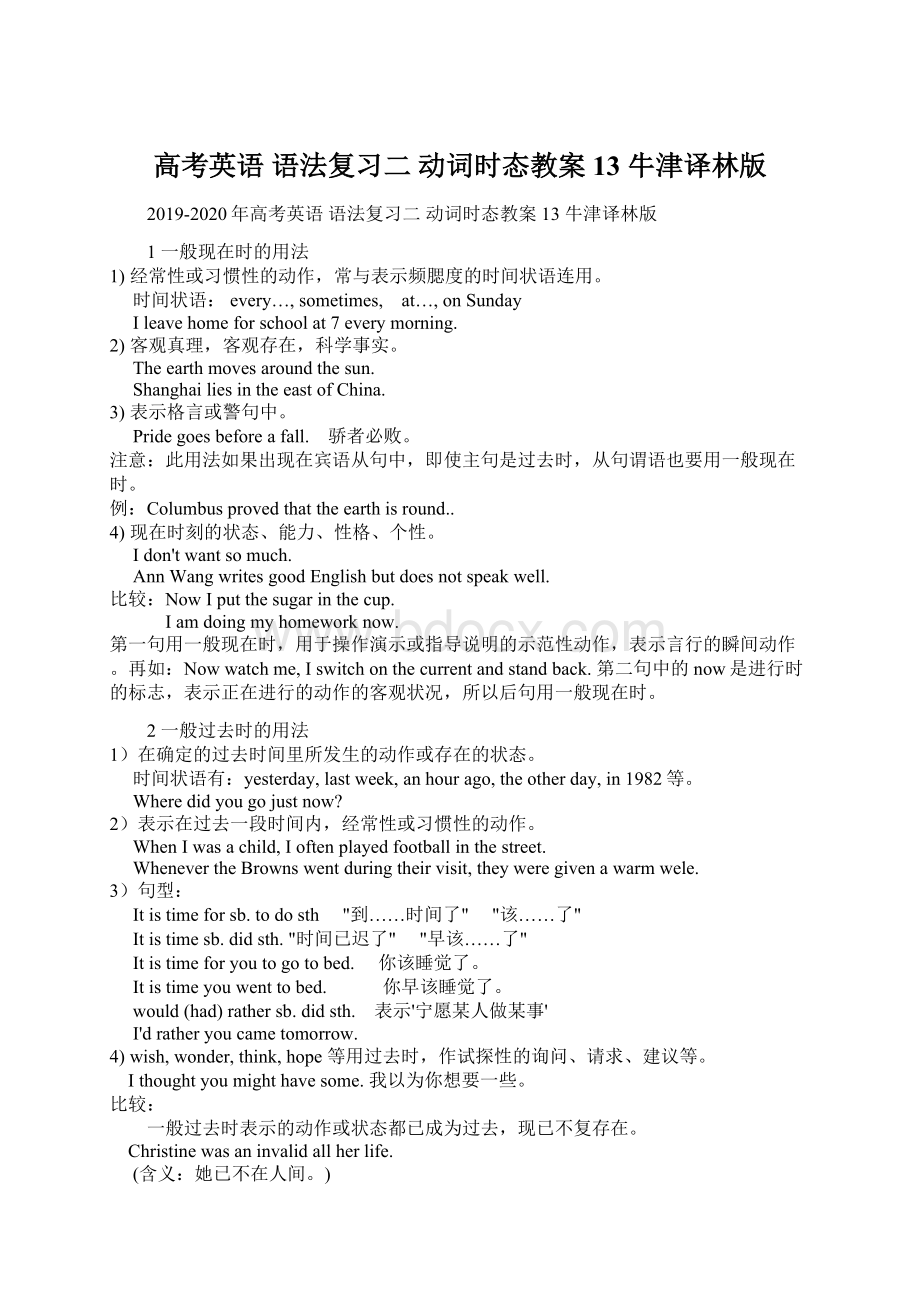高考英语 语法复习二 动词时态教案13 牛津译林版.docx
《高考英语 语法复习二 动词时态教案13 牛津译林版.docx》由会员分享,可在线阅读,更多相关《高考英语 语法复习二 动词时态教案13 牛津译林版.docx(14页珍藏版)》请在冰豆网上搜索。

高考英语语法复习二动词时态教案13牛津译林版
2019-2020年高考英语语法复习二动词时态教案13牛津译林版
1一般现在时的用法
1)经常性或习惯性的动作,常与表示频腮度的时间状语连用。
时间状语:
every…,sometimes, at…,onSunday
Ileavehomeforschoolat7everymorning.
2)客观真理,客观存在,科学事实。
Theearthmovesaroundthesun.
ShanghailiesintheeastofChina.
3)表示格言或警句中。
Pridegoesbeforeafall. 骄者必败。
注意:
此用法如果出现在宾语从句中,即使主句是过去时,从句谓语也要用一般现在时。
例:
Columbusprovedthattheearthisround..
4)现在时刻的状态、能力、性格、个性。
Idon'twantsomuch.
AnnWangwritesgoodEnglishbutdoesnotspeakwell.
比较:
NowIputthesugarinthecup.
Iamdoingmyhomeworknow.
第一句用一般现在时,用于操作演示或指导说明的示范性动作,表示言行的瞬间动作。
再如:
Nowwatchme,Iswitchonthecurrentandstandback.第二句中的now是进行时的标志,表示正在进行的动作的客观状况,所以后句用一般现在时。
2一般过去时的用法
1)在确定的过去时间里所发生的动作或存在的状态。
时间状语有:
yesterday,lastweek,anhourago,theotherday,in1982等。
Wheredidyougojustnow?
2)表示在过去一段时间内,经常性或习惯性的动作。
WhenIwasachild,Ioftenplayedfootballinthestreet.
WhenevertheBrownswentduringtheirvisit,theyweregivenawarmwele.
3)句型:
Itistimeforsb.todosth "到……时间了" "该……了"
Itistimesb.didsth."时间已迟了" "早该……了"
Itistimeforyoutogotobed. 你该睡觉了。
Itistimeyouwenttobed. 你早该睡觉了。
would(had)rathersb.didsth. 表示'宁愿某人做某事'
I'dratheryoucametomorrow.
4)wish,wonder,think,hope等用过去时,作试探性的询问、请求、建议等。
Ithoughtyoumighthavesome.我以为你想要一些。
比较:
一般过去时表示的动作或状态都已成为过去,现已不复存在。
Christinewasaninvalidallherlife.
(含义:
她已不在人间。
)
Christinehasbeenaninvalidallherlife.
(含义:
她现在还活着)
Mrs.DarbylivedinKentuckyforsevenyears.
(含义:
达比太太已不再住在肯塔基州。
)
Mrs.DarbyhaslivedinKentuckyforsevenyears.
(含义:
现在还住在肯塔基州,有可能指刚离去)
注意:
用过去时表示现在,表示委婉语气。
1)动词want,hope,wonder,think,intend等。
Didyouwantanythingelse?
Iwonderedifyoucouldhelpme.
2)情态动词could,would.
Couldyoulendmeyourbike?
3usedto/beusedto
usedto+do:
"过去常常"表示过去习惯性的动作或状态,但如今已不存在。
Motherusednottobesoforgetful.
Scarfusedtotakeawalk. (过去常常散步)
beusedto+doing:
对……已感到习惯,或"习惯于",to是介词,后需加名词或动名词。
Heisusedtoavegetariandiet.
Scarfisusedtotakingawalk.(现在习惯于散步)
典型例题
----Yourphonenumberagain?
I___quitecatchit.
----It's69568442.
A.didn't B.couldn't C.don't D.can't
答案A.本句虽没有明确的时间状语,但从语意上看出,在听的时候没有听懂这个动作发生在过去,因此应用过去时。
4一般将来时
1) shall用于第一人称,常被will所代替。
will在陈述句中用于各人称,在争求意见时常用于第二人称。
WhichparagraphshallIreadfirst.
Willyoubeathomeatseventhisevening?
2) begoingto+不定式,表示将来。
a.主语的意图,即将做某事。
Whatareyougoingtodotomorrow?
b.计划,安排要发生的事。
Theplayisgoingtobeproducednextmonth。
c.有迹象要发生的事
Lookatthedarkclouds,thereisgoingtobeastorm.
3) be+不定式表将来,按计划或正式安排将发生的事。
WearetodiscussthereportnextSaturday.
4) beaboutto+不定式,意为马上做某事。
HeisabouttoleaveforBeijing.
注意:
beaboutto不能与tomorrow,nextweek等表示明确将来时的时间状语连用。
5begoingto/will
用于条件句时,begoingto 表将来
will 表意愿
Ifyouaregoingtomakeajourney,you'dbettergetreadyforitassoonaspossible.
Nowifyouwilltakeoffyourclothes,wewillfitthenewclothesonyouinfrontofthemirror.
6beto和begoingto
beto表示客观安排或受人指示而做某事。
begoingto表示主观的打算或计划。
Iamtoplayfootballtomorrowafternoon. (客观安排)
I'mgoingtoplayfootballtomorrowafternoon.(主观安排)
7一般现在时表将来
1)下列动词:
e,go,arrive,leave,start,begin,return的一般现在时表将来。
这主要用来表示在时间上已确定或安排好的事情。
Thetrainleavesatsixtomorrowmorning.
Whendoesthebusstar?
Itstarsintenminutes.
2)倒装句,表示动作正在进行,如:
Hereesthebus.=Thebusising.
Theregoesthebell.=Thebellisringing.
3)在时间或条件句中。
WhenBilles(不是wille),askhimtowaitforme.
I'llwritetoyouassoonasIarrivethere.
4)在动词hope,takecarethat,makesurethat等后。
Ihopetheyhaveanicetimenextweek.
Makesurethatthewindowsareclosedbeforeyouleavetheroom.
8用现在进行时表示将来
意为:
"意图"、"打算"、"安排"、常用于人。
常用词为e,go,start,arrive,leave,stay等。
I'mleavingtomorrow.
Areyoustayingheretillnextweek?
9现在完成时
现在完成时用来表示之前已发生或完成的动作或状 态,其结果的确和现在有联系。
动作或状态发生在过去 但它的影响现在还存在;也可表示持续到现在的动作或 状态。
其构成:
have(has)+过去分词。
10比较过去时与现在完成时
1)过去时表示过去某时发生的动作或单纯叙述过去的事情,强调动作;现在完成时为过去发生的,强调过去的事情对现在的影响,强调的是影响。
2)过去时常与具体的时间状语连用,而现在完成时通常与模糊的时间状语连用,或无时间状语。
一般过去时的时间状语:
yesterday,lastweek,…ago,in1980,inOctober,justnow,具体的时间状语
共同的时间状语:
thismorning,tonight,thisApril,now,once,before,already,recently,lately
现在完成时的时间状语
for,since,sofar,ever,never,just,yet, till/until,uptonow,inpastyears,always,
不确定的时间状语
3)现在完成时可表示持续到现在的动作或状态,动词一般是延续性的,如live,teach,learn,work,study,know.
过去时常用的非持续性动词有e,go,leave,start,die,finish,bee,getmarried等。
举例:
Isawthisfilmyesterday.
(强调看的动作发生过了。
)
Ihaveseenthisfilm.
(强调对现在的影响,电影的内容已经知道了。
)
Whydidyougetupsoearly?
(强调起床的动作已发生过了。
)
Whohasn'thandedinhispaper?
(强调有卷子,可能为不公平竞争。
)
ShehasreturnedfromParis.
她已从巴黎回来了。
Shereturnedyesterday.
她是昨天回来了。
HehasbeenintheLeagueforthreeyears.
(在团内的状态可延续)
HehasbeenaLeaguememberforthreeyears.
(是团员的状态可持续)
HejoinedtheLeaguethreeyearsago.
(三年前入团,joined为短暂行为。
)
Ihavefinishedmyhomeworknow.
---WillsomebodygoandgetDr.White?
---He'salreadybeensentfor.
句子中如有过去时的时间副词(如yesterday,last,week,in1960)时,不能使用现在完成时,要用过去时。
(错)Tomhaswrittenalettertohisparentslastnight.
(对)Tomwrotealettertohisparentslastnight.
11用于现在完成时的句型
1)Itisthefirst/secondtime….that…结构中的从句部分,用现在完成时。
ItisthefirsttimethatIhavevisitedthecity.
Itwasthethirdtimethattheboyhadbeenlate.
2)Thisisthe…that…结构,that从句要用现在完成时.
ThisisthebestfilmthatI've(ever)seen.
这是我看过的最好的电影。
Thisisthefirsttime(that)I'veheardhimsing. 这是我第一次听他唱歌。
典型例题
(1)---Doyouknowourtownatall?
---No,thisisthefirsttimeI___here.
A.was B.havebeen C.came D.aming
答案B.Thisisthefirsttime后面所加从句应为现在完成时,故选B。
(2)---Haveyou____beentoourtownbefore?
---No,it'sthefirsttimeI___here.
A.even,e B.even,havee C.ever,e D.ever,havee
答案D.ever意为曾经或无论何时,反意词为never,此两词常用于完成时。
ThisisthelargestfishIhaveeverseen.Itis/wasthefirsttime+that-clause的句型中,从句要用完成时。
注意:
非延续性动词的否定形式可以与表示延续时间的状语连用。
即动作不发生的状态是可以持续的。
(错)Ihavereceivedhisletterforamonth.
(对)Ihaven'treceivedhisletterforalmostamonth.
12比较since和for
Since用来说明动作起始时间,for用来说明动作延续时间长度。
Ihavelivedhereformorethantwentyyears.
IhavelivedheresinceIwasborn..
Myaunthasworkedinaclinicsince1949.
Somenewoilfieldshavebeenopenedupsince1976.
IhaveknownXiaoLisinceshewasalittlegirl.
MybrotherhasbeenintheYouthLeaguefortwoyears.
Ihavenotheardfrommyuncleforalongtime.
注意:
并非有for作为时间状语的句子都用现在完成时。
Iworkedhereformorethantwentyyears.
(我现在已不在这里工作。
)
Ihaveworkedhereformanyyears.
(现在我仍在这里工作。
)
小窍门:
当现在完成时+一段时间,这一结构中,我们用下面的公式转化,很容易就能排除非延续动词在完成时中的误使。
1) (对)TomhasstudiedRussianforthreeyears.
=TombegantostudyRussianthreeyearsago,andisstillstudyingitnow.
2) (错)Harryhasgotmarriedforsixyears.
=Harrybegantogetmarriedsixyearsago,andisstillgettingmarriednow.
显然,第二句不对,它应改为Harrygotmarriedsixyearsago. 或Harryhasbeenmarriedforsixyears.
13since的四种用法
1)since+过去一个时间点 (如具体的年、月、日期、钟点、1980,lastmonth,halfpastsix)。
Ihavebeenheresince1989.
2)since+一段时间+ago
Ihavebeenheresincefivemonthsago.
3)since+从句
Greatchangeshavetakenplacesinceyouleft.
Considerabletimehaselapsedsincewehavebeenhere.
4)Itis+一段时间+since从句
ItistwoyearssinceIbecameapostgraduatestudent.
14延续动词与瞬间动词
1)用于完成时的区别
延续动词表示经验、经历;瞬间动词表示行为的结果,不能与表示段的时间状语连用。
Hehaspletedthework. 他已完成了那项工作。
(表结果)
I'veknownhimsincethen. 我从那时起就认识他了。
(表经历)
2) 用于till/until从句的差异
延续动词用于肯定句,表示"做……直到……"瞬间动词用于否定句,表示"到……,才……"
Hedidn'tebackuntilteno'clock.
他到10点才回来。
Hesleptuntilteno'clock.
他一直睡到10点。
典型例题
1.Youdon'tneedtodescribeher.I___herseveraltimes.
A.hadmet B.havemet C.met D.meet
答案B.首先本题后句强调对现在的影响,我知道她的模样,你不用描述。
再次,severaltimes告知为反复发生的动作,因此用现在完成时。
2.---I'msorrytokeepyouwaiting.
---Oh,notatall.I___hereonlyafewminutes.
A.havebeen B.hadbeen C.was D.willbe
答案A.等待的动作由过去开始,持续到现在,应用现在完成时。
15过去完成时
1)概念:
表示过去的过去
----|-------|-----|---->其构成是had+过去分词构成。
那时以前 那时 现在
2)用法
a. 在told,said,knew,heard,thought等动词后的宾语从句。
Shesaid(that)shehadneverbeentoParis.
b.状语从句
在过去不同时间发生的两个动作中,发生在先,用过去完成时;发生在后,用一般过去时。
Whenthepolicearrived,thethieveshadrunaway.
c.表示意向的动词,如hope,wish,expect,think,intend,mean,suppose等,用过去完成时表示"原本…,未能…"
Wehadhopedthatyouwoulde,butyoudidn't.
3) 过去完成时的时间状语before,by,until,when,after,once,assoonas。
HesaidthathehadlearnedsomeEnglishbefore.
Bythetimehewastwelve,Edisonhadbegantomakealivingbyhimself.
Tomwasdisappointedthatmostoftheguestshadleftwhenhearrivedattheparty.
典型例题
Thestudents___busilywhenMissBrownwenttogetabookshe___intheoffice.
A.hadwritten,left B,werewriting,hasleft C.hadwritten,hadleft D.werewriting,hadleft
答案D."把书忘在办公室"发生在"去取书"这一过去的动作之前,因此"忘了书"这一动作发生在过去的过去,用过去完成时。
句中when表示的是时间的一点,表示在"同学们正忙于……"这一背景下,when所引导的动作发生。
因此
前一句应用过去进行时。
注意:
hadno…when还没等……就……
hadnosooner…than 刚……就……
Hehadnosoonerboughtthecarthanhesoldit.
16用一般过去时代替完成时
1) 两个动作如按顺序发生,又不强调先后,或用then,and,but等连词时,多用一般过去时。
Whenshesawthemouse,shescreamed.
MyauntgavemeahatandIlostit.
2)两个动作相继发生,可用一般过去时;如第一个动作需要若干时间完成,用过去完成时